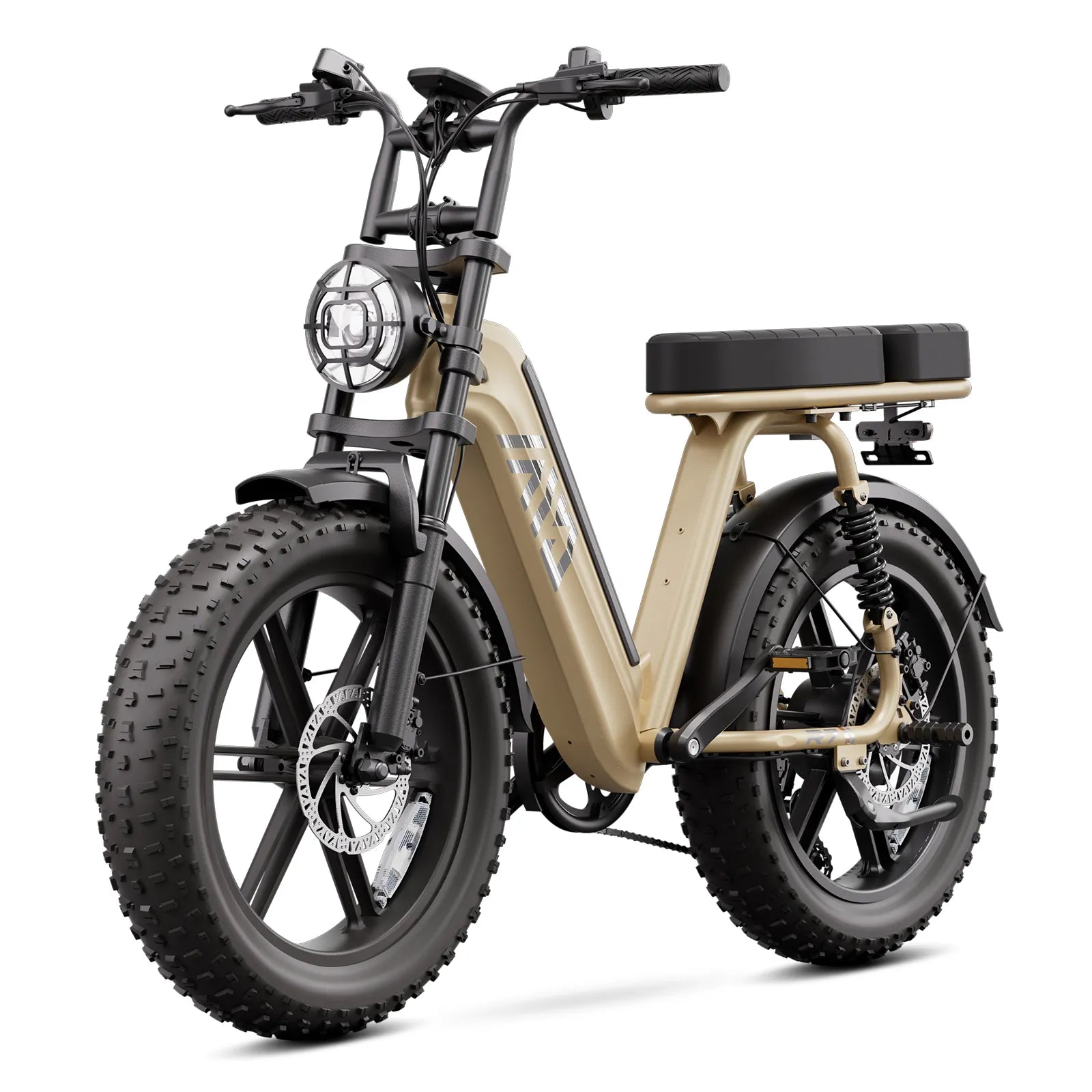Choosing between mid-drive and hub motors for your e-bike depends on your riding style, terrain, and maintenance preferences. Mid-drive motors offer better torque, efficiency, and natural pedaling feel, ideal for hill climbing and off-road use. Hub motors provide simplicity, lower cost, and less drivetrain wear, making them suitable for city commuting and flat terrain. Are the batteries removable?
What Are the Key Differences Between Mid-Drive and Hub Motors?
Mid-drive motors are located at the bike’s crank area, applying power directly to the chain and utilizing the bike’s gears, which results in efficient power distribution and better torque for climbing hills. Hub motors are installed in the wheel hub (usually rear or front), driving the wheel directly without interacting with the drivetrain, offering simpler mechanics and less wear on the chain.
Mid-drive motors centralize weight for better balance and handling, while hub motors add weight to the wheel, potentially affecting maneuverability. Mid-drives tend to be more complex and costly, whereas hub motors are generally more affordable and lower maintenance.
How Do Mid-Drive and Hub Motors Compare in Performance and Efficiency?
Mid-drive motors excel in efficiency, especially on hilly or off-road terrain, by leveraging the bike’s gears to maintain optimal cadence and torque. This results in longer battery range and better hill-climbing ability. Hub motors perform adequately on flat terrain and city commuting but can struggle with steep inclines and heavy loads due to fixed gear ratios.
Efficiency Comparison Chart
| Aspect | Mid-Drive Motor | Hub Motor |
|---|---|---|
| Torque | High, gear-assisted | Moderate, fixed gear |
| Hill Climbing | Excellent | Limited |
| Battery Efficiency | Better on varied terrain | Adequate on flat terrain |
| Power Delivery | Smooth, natural feel | Less natural, direct wheel drive |
Which Motor Type Offers Better Handling and Ride Quality?
Mid-drive motors provide superior handling due to their central placement, which lowers the bike’s center of gravity and balances weight distribution. This leads to a more natural, agile ride, especially noticeable on technical trails or sharp turns. Hub motors, being located in the wheel hub, add weight to the bike’s extremities, potentially making handling feel less responsive and increasing unsprung mass, which can affect ride comfort.
What Are the Maintenance and Durability Considerations for Each Motor?
Hub motors are simpler mechanically, requiring less frequent maintenance and having fewer components exposed to wear. They also cause less strain on the bike’s drivetrain since they don’t apply power through the chain. Mid-drive motors, while offering better performance, place additional stress on the chain and gears, potentially leading to more frequent drivetrain maintenance and part replacement.
How Do Cost and Installation Complexity Differ Between Mid-Drive and Hub Motors?
Hub motors are generally less expensive and easier to install, often compatible with standard bike frames without modification. Mid-drive motors require specially designed frames to accommodate the motor at the bottom bracket and typically come at a higher price point due to their complexity and performance benefits.
Which TST EBike Models Feature Mid-Drive or Hub Motors and How Do They Suit Different Riders?
TST eBikes like the TST TrailPro feature mid-drive motors, offering better climbing power and balanced weight—ideal for off-road and performance riders. In contrast, models like the TST CityCruise use hub motors, providing quiet, low-maintenance operation for smooth city commuting. Mid-drive systems suit those tackling steep terrain, while hub motors are perfect for flat roads and everyday urban travel, giving each rider a tailored experience based on terrain and usage.
TST EBike offers models with motor systems optimized for diverse terrains and rider needs:
- 26-inch TST EBike Model: Equipped with a mid-drive motor ideal for rough terrains like snow and sand, providing high torque and excellent hill climbing for adventurous riders.
- 27-inch TST EBike Model: Designed for daily commuting and mountain biking, featuring a motor system (often mid-drive) that balances power and agility on mixed terrain and urban roads.
Both models incorporate high-quality batteries and durable frames, ensuring reliable performance whether you prioritize off-road capability or urban versatility.
TST EBike Model Motor Comparison Chart
| Feature | 26-inch Model | 27-inch Model |
|---|---|---|
| Motor Type | Mid-Drive | Mid-Drive |
| Terrain Suitability | Rough terrains (snow, sand) | Commuting, mountain biking |
| Torque | High | Balanced |
| Handling | Stable, rugged | Agile, responsive |
| Ideal Rider | Off-road enthusiasts | Urban commuters, trail riders |
Why Should Riders Consider Their Terrain and Riding Style When Choosing a Motor?
Your terrain and riding style dictate the motor best suited for your needs. If you frequently ride hilly or off-road trails, a mid-drive motor’s torque and gear integration provide better performance and efficiency. For flat, urban environments and casual rides, a hub motor’s simplicity and lower cost may be more practical.
Buying Tips
When selecting between mid-drive and hub motors, consider these factors:
- Assess your typical terrain: Choose mid-drive motors for hilly or off-road use; hub motors for flat, urban riding.
- Evaluate maintenance willingness: Hub motors require less drivetrain upkeep; mid-drives need more attention to chain and gears.
- Budget accordingly: Hub motors are more affordable; mid-drives cost more but offer superior performance.
- Check bike compatibility: Mid-drive motors need specialized frames; hub motors fit most standard frames.
- Consider TST EBike models: The 26-inch model with mid-drive motor excels in rough terrain, while the 27-inch model suits mixed and commuting terrains.
- Prioritize quality and support: Opt for brands like TST EBike that focus on consumer feedback and quality control.
E-bikes have become an increasingly popular mode of transportation and leisure activity, offering a greener and more efficient alternative to traditional bikes. When purchasing an e-bike, one crucial decision you'll need to make is choosing the right motor. While there are various options available, mid-drive and hub motors are two commonly used types that offer different benefits and functionalities. In this article, we will explore the differences between these motors so that you can make an informed decision when buying your next e-bike.
Understanding E-Bike Motors
E-bike motors are primarily categorized into mid-drive and hub motors. Mid-drive motors are centrally located near the pedals, offering balanced weight distribution and efficient power transfer through the bike's gears. Hub motors are positioned in the wheel hub, providing direct propulsion and a simpler design. The choice between them affects ride quality, maintenance, and cost.
Before diving into the comparison, it's essential to understand how e-bike motors work. The primary function of any motor in an electric bike is to power the pedal assist system (PAS) and provide additional assistance while pedaling. Some models also include a throttle assist feature powered by the motor for added convenience.
Mid-Drive Motors
Mid-drive motors deliver power directly to the bike's chain, leveraging the gearing system for efficient energy use and higher torque. This setup offers better handling and is ideal for hilly terrains. However, they are more complex, may require more maintenance, and are typically more expensive than hub motors.
Mid-drive motors are typically found on commuter and fat tire e-bikes designed for smooth rides with increased range capabilities. These motors generate torque through a shaft connected to chains that drive the crank arms attached to the pedals. Placing the motor at the centermost point creates a low center of gravity, ensuring better balance during rides.
Advantages:
- Improved handling: With their central position, mid-drive motors offer superior handling compared to hub motors.
- Increased efficiency: The low center of gravity enhances overall performance while providing smoother acceleration.
- Better range capability: Due to their efficiency, mid-drive motors excel on longer journeys where every ounce of energy counts.
Disadvantages:
- More maintenance required: Mid-drive motors consist of several moving parts that may require more frequent maintenance compared to hub drives.
- Higher possibility of breakdowns: The complex mechanism increases chances of specific parts wearing out faster over time.
Hub Motors
Hub motors are integrated into the wheel hub, providing propulsion without engaging the bike's gears. They are simpler, quieter, and require less maintenance, making them suitable for flat terrains and urban commuting. However, they may offer less efficient power use on inclines and can affect the bike's balance due to weight distribution.
Hub motors are known for their simplicity and efficiency, making them ideal for riders who prefer a hassle-free experience. These gearless motors are located in the rear wheel hub and serve as the e-bike's rear axle. Unlike mid-drive motors, the shaft of a hub motor remains fixed while the motor itself moves and rotates around it to generate torque.
Advantages:
- Easy maintenance: Hub motors have fewer parts compared to mid-drive motors, resulting in less frequent maintenance.
- Durability: Due to their simplistic nature, hub motors tend to be more durable and reliable over time.
- Cost-effective: The simplicity of hub drives translates into lower production costs, making e-bikes with these motors more affordable.
Disadvantages:
- Slightly inferior handling: While still suitable for most terrains, hub drive e-bikes may not offer the same level of handling as those equipped with mid-drive systems.
- Potentially bumpier rides: The fixed shaft design can result in slightly jerkier acceleration compared to mid-drive models.
Ride Quality Comparison
Mid-drive motors offer a more natural and responsive riding experience, especially on varied terrains, due to their central placement and use of the bike's gears. Hub motors provide a smoother, quieter ride on flat surfaces but may struggle with efficiency and handling on hills or uneven terrains.
Both mid-drive and hub motor-equipped e-bikes provide enjoyable rides with unique characteristics.
- Smoothness & Acceleration: Mid-drive systems offer smoother acceleration without rocking back-and-forth sensations often experienced with hub-driven models.
- Efficiency & Range Capability: The central placement of mid-drive motors contributes to better handling and greater efficiency, resulting in longer rides.
- Durability: While mid-drive motors may offer a marginally better ride experience, hub motors are known for their robustness and ability to withstand rough terrain.
Cost Considerations
Hub motor e-bikes are generally more affordable upfront and have lower maintenance costs due to their simpler design. Mid-drive motor e-bikes, while offering superior performance and efficiency, come with higher initial costs and potentially increased maintenance expenses due to their complex integration with the bike's drivetrain.
When it comes to cost, hub motors tend to be more budget-friendly compared to mid-drive options due to their simpler construction with fewer parts.
- Affordability: Hub-driven e-bikes generally have a lower price point than those equipped with mid-drive systems.
- Maintenance Costs: The simplicity of hub motors translates into reduced maintenance needs and potentially lower repair expenses over time.
Choosing Your Perfect Match
If you frequently ride on hilly or varied terrains and seek a natural riding feel with efficient power use, a mid-drive motor e-bike is suitable. For flat, urban commuting with minimal maintenance and lower costs, a hub motor e-bike is ideal. Consider your typical riding conditions, budget, and maintenance preferences when choosing between the two.
When deciding between a mid-drive or hub motor for your e-bike, it's crucial to consider your specific needs and riding preferences:
- Commuting or long-distance rides: If you plan on using your e-bike mainly for commuting purposes or longer journeys where range is essential, a mid-drive motor offers excellent efficiency and performance advantages.
- Simplified maintenance: If ease of maintenance is high on your priority list or if you're concerned about potential breakdowns affecting your ride experience frequently, then a hub drive system might be better suited for you.
- Budget considerations: Hub drives generally cost less due to their simpler construction. If budget plays a significant role in your decision-making process without compromising overall quality and functionality, opting for an e-bike with a hub motor could be beneficial.
Conclusion
Choosing between mid-drive and hub motors significantly impacts your overall e-bike experience. Assessing factors such as usage requirements (commuting vs. off-roading), desired handling capabilities, maintenance preferences, budget considerations will help determine the ideal motor type for you. Both mid-drive and hub motors have their own strengths; however,
mid-drives excel in terms of handling control while hub drives offer simplicity and lower maintenance costs.
Researching thoroughly before making your decision will ensure that you find the perfect match that meets your specific needs while maximizing enjoyment on every ride with your new electric bike from TST Ebikes!





























Leave a comment
All comments are moderated before being published.
This site is protected by hCaptcha and the hCaptcha Privacy Policy and Terms of Service apply.